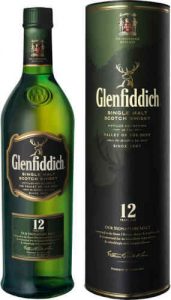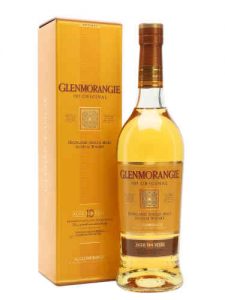Back in 2009 we published our Gateway Series, and for this one decided to do something a little different. We decided that a head-to-head-to-head tasting of the Three Glens would be a nice twist on our usual reviews. There was some discussion if single malt scotches should even be included as a “gateway” drink given their tendency toward higher prices and a more refined palate. That said, if you are venturing into single malts for the first time you’re likely to cross paths with one of these three. Here are the results of our tasting of The Glenlivet 12 Year Old, Glenfiddich 12 Year Old, and Glenmorangie The Original. Enjoy!
The Glenlivet 12 Year Old
Speyside Single Malt Scotch Whisky
40% ABV
$25 to $40
Website

What the Distillery Says:
Smooth, balanced, fruity… an invitation to indulgence in liquid form.
This whisky has been called a lot of things in its time: smooth, fruity, complex, sophisticated, entertaining, classic. The Original Malt Whisky Almanac says: “A first-class malt. One of the most popular malts in the world – deservedly so.” Representing The Glenlivet’s signature style, this classic malt is first matured in traditional oak, before spending time in American oak casks which impart notes of vanilla and gives the whisky it’s distinctive smoothness. The mineral-rich water that comes from Josie’s Well helps form the flavours during mashing and fermentation, whilst the specific height and width of the copper stills add a delicate yet complex character. Keep a bottle on hand for every occasion.
Color: Bright, vibrant gold
Cask: European and American oak
Nose: Fruity and summery
Palate: Well-balanced and fruity, with strong pineapple notes
Flavor: Delicately balanced with strong pineapple notes
Finish: Long, creamy, smooth
What Richard Says:
Nose: Light grass with sweet fruit notes pushing through. No note of earthiness (peat, smoke, etc.) which is a little surprising. Water tends to fade the nose without continued agitation.
Palate: Apples, grass (like sitting in a meadow), and sweet cream (pre-whipped sweetened heavy cream). Water mutes the more delicate notes.
Finish: Short and fleeting. Not much but it leaves you with notes of apple skin.
Comments: Full sweetness through the palate as opposed to a typical fore tongue sweetness. Overall it was better than expected. I’ve had this a thousand times and I’ll have it a thousand more. It’s a great entry scotch but not necessarily typical of like scotches. Good for fans of a fruiter white wine.
What Matt Says:
Nose: Crisp green apples, caramel, candy apple coating. This is a very fruity and accessible nose for the neophyte but not very “Scotch-y.” No smoke and no earth.
Palate: The green apple is still present, but the sweeter notes move from caramel to sweet cream. There is something I can’t quite grasp that Richard calls grassy. I suppose I could call it saw grass, but it is very vague and faint.
Finish: Short and tart. The skin of a Granny Smith apple.
Comments: This is a pleasant dram with lots of crisp fruit. It is a great introduction for folks with a fondness for fruity drinks. Don’t bother adding water or using this as a mixer. Mixing kills the flavor. Among single malts, this is decidedly average (that’s why it is so popular). However, this stands out among gateway whiskies.
Glenfiddich 12 Year Old
Speyside Single Malt Scotch Whisky
40% ABV
$35
Website

What the Distillery Says:
Flowing in the Valley of the Deer since 1887, our family’s signature expression is the world’s most awarded single malt Scotch whisky*.
With a unique freshness from the same Highland spring water we’ve used since 1887, its distinctive fruitiness comes from the high cut point William Grant always insisted upon.
Carefully matured in the finest American oak and European oak sherry casks for at least 12 years, it is mellowed in oak marrying tuns to create its sweet and subtle oak flavours.
Creamy with a long, smooth and mellow finish, our 12 Year Old is the perfect example of Glenfiddich’s unique Speyside style and is widely proclaimed the best dram in the valley.
TRADITION IN TUNS
Marrying single malt whisky is a tradition we have passed down through generations. Our whisky is matured for 12 years in Olorosso, European oak sherry and American oak casks before being married by our Malt Master, Brian Kinsman, in specially designed, uniquely sized oak marrying tuns for 9 months.
THE SWEETEST PART
In the first few weeks of Glenfiddich, William Grant put his son Alec in charge of the stills. His job was to find the best part of the distillate. He chose only the heart of the spirit, although good spirit was lost. We continue to use the same unusually high cut point for an unequivocally clean, estery, sweet and fruity distillate. Ready for maturation.
PROTECTING OUR SPRING
Since 1887, we’ve used water from the same spring William Grant did. He could tell the Robbie Dhu spring would remain crucial to the future of our distillery, so bought more acres of land around it than he could afford, guaranteeing the purity of our whisky forever.
Tasting Notes
COLOUR: Golden
NOSE: Distinctively fresh and fruity with a hint of pear. Beautifully crafted and delicately balanced.
TASTE: Characteristic sweet, fruity notes. Develops into butterscotch, cream, malt and subtle oak flavours.
FINISH: A long smooth and mellow finish.
What Richard Says:
Nose: Honey/honeysuckle with butter but it’s more like a brown butter sauce or clarified butter. Not to sound too snotty but it has a really nice bouquet. More of a green/under ripened note develops with water.
Palate: Initially not very much on the palate. Upon further investigation this is a more peppered honey on the palate compared to the nose. It has a creamier mouth feel.
Finish: Leave the mouth feeling…chewy. A slight vegetal note as the sweetness clears the throat. More pepper is left behind.
Comments: There’s a reason this is sold more widely than any other single malt. It’s a very pleasant dram. A solid go-to malt.
What Matt Says:
Nose: Honey butter and those little toast bites you can buy at Ikea (like heavily toasted mini baguettes).
Palate: Buttery, toasty, viscous, clove, slightly burnt toast bites. The palate gives an interesting sensation. The whisky forms a meniscus then bursts on the center of the tongue. Water opens the nose to some green apple, but kills the palate.
Finish: Short finish with a slight burn. Glenfiddich makes my mouth water and my cheeks feel full (almost swollen).
Comments: Of the Glens, Glenfiddich is the one that I would suggest to anyone interested in getting into Single Malts. It is not overly complex or overly simple and has a very accessible flavor profile. Like the Glenlivet, this stands out only compared to other gateway drams. This is my favorite gateway dram despite the fact that I prefer Glenmorangie (see notes below).
Glenmorangie Original 10 Years
Highland Single Malt Scotch Whisky
43% ABV
$35
Website

What the Distillery Says:
Glenmorangie Original is an inviting single malt whisky, acclaimed and appreciated by luxury spirit drinkers around the world.
The original expression of Glenmorangie’s elegant, floral spirit that is renowned the world over for exquisite finesse and alluring complexity, The Original is the intriguing marriage of delicate spirit and long, slow maturation.
The taste characteristics from the first-fill bourbon casks that permeates the majority of the ages spirit, coupled with the increased proportion of our ‘designer casks’ (made from slow-growth, air-dried American oak from the Ozark Mountains of Missouri), results in a delicious spirit that enhances the relaxed and convivial mood of the group by igniting the senses.
The Original is, quite simply, the most delicate and deliciously complex single malt whisky in the world.
What Richard Says:
Nose: Yeast rolls and tart apples. For only 3% more alcohol than the other two Glens it makes a big difference on the nose. Much more alcohol. Water cuts down the alcohol but all else remains the same.
Palate: Viscous mouth feel with a bit of sweetness but more tart. Almost like Dr. Brown’s Cream Soda. Water mutes the flavor.
Finish: There’s like a viscous hold on the finish and then it releases from the mouth like a dam break.
Comments: Glenmorangie seems to move away from a gateway malt to be more of a defined palate that needs to be sought out as opposed to embracing your. Their reformulation over the old 10 Year is quite noticeable. Would I call it “the most delicate and deliciously complex single malt whisky in the world”? No. But it is quite good.
What Matt Says:
Nose: Yeast rolls, tart apples and a lot of alcohol.
Palate: Birch beer, herbal, faint notes of licorice. Water draws out some caramel sweetness but creates an odd sensation of a crystalline caramel shell with nothing inside.
Finish: Short and slightly numbing
Comments: I find it odd that Glenmorangie is so often mentioned in the same breath as Glenfiddich and Glenlivet. Both ‘fiddich and ‘livet are Speyside malts while Glenmorangie comes from the Highland region. Furthermore, the taste profiles are very different. Glenmorangie is herbal and slightly medicinal compared to the fruitiness of the other two. The extra alcohol content is small, but prominent. This dram is for a decidedly different palate. While this suits my palate best of the three, I cannot recommend it over the Glenfiddich as a gateway dram.
Rating:
This was a very interesting experience. It brought up a lot of questions about the nature of ratings and whether they should be a definitive scale or a relative scale. Definitively we rated all three as average because while good, they are far overshadowed by world of single malts. On a relative scale all three standout from everything we’ve tried in the gateway series. So if you want an overall rating they would each be Average/Stands Out. Personally, Matt and I both picked Glenfiddich from the group. No matter which one you pick up I don’t think you’ll be disappointed.




